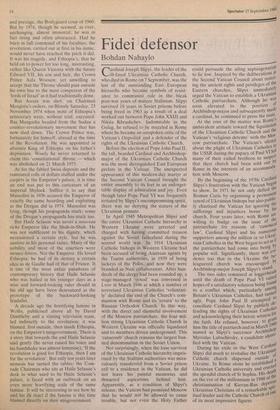Fidei defensor
Bohdan Nahaylo
riardinal Joseph Slipyi, the leader of the k.../ill-fated Ukrainian Catholic Church, who died in Rome on 7 September, was the last of the outstanding East European hierarchs who became symbols of resist- ance to communist rule in the bleak post-war years of mature Stalinism. Slipyi survived 18 years in Soviet prisons before being freed in 1963 as a result of a deal worked out between Pope John XXIII and Nikita Khrushchev. Indomitable in the Gulag, he refused to be muzzled in Rome where he became an outspoken critic of the Vatican's Ostpolitik and a defender of the rights of the Ukrainian Catholic Church.
Before the election of Pope John Paul II, the tall, bearded Cardinal and Archbishop- major of the Ukrainian Catholic Church was the most distinguished East European prelate in the Vatican. The unexpected appearance of this modern-day martyr at the Second Vatican Council brought the entire assembly to its feet in an unforget- table display of admiration and joy. Even though later Pope Paul VI was frequently irritated by Slipyi's uncompromising spirit, there was no denying the stature of the Ukrainian primate.
In April 1945 Metropolitan Slipyi and the entire Ukrainian Catholic hierarchy in Western Ukraine were arrested and charged with having committed treason against the Soviet fatherland during the second world war. In 1914 Ukrainian Catholic bishops in Western Ukraine had been accused of being Austrian agents by the Tsarist authorities, in 1939 of being lackeys of the Poles, and now they were branded as Nazi collaborators. After hun- dreds of the clergy had been rounded up, a stage-managed 'synod' was convened in Lvov in March 1946 at which a number of terrorised Ukrainian Catholics 'voluntari- ly' declaied the end of the Church's com- munion with Rome and its 'return' to the Russian Orthodox Church. In this way, with the direct and shameful involvement of the Moscow patriarchate, the four mil- lion strong Ukrainian Catholic Church in Western Ukraine was officially liquidated and its members driven underground. This `catacomb' church remains the largest ban- ned denomination in the Soviet Union.
Not surprisingly, when the lone survivor of the Ukrainian Catholic hierarchy impris- oned by the Stalinist authorities was mira- culously transferred from a Soviet prison cell to a residence in the Vatican, he did not leave his painful memories and thwarted aspirations behind him. Apparently, as a condition of Slipyi's release, the Vatican had promised Moscow that he would not be allowed to cause trouble, but not even the Holy Father
could persuade the ailing septuagenarian to lie low. Inspired by the deliberations at the Second Vatican Council about restor- ing the ancient rights and privileges of the Eastern churches, Slipyi immediately urged the Vatican to establish a Ukrainian Catholic patriarchate. Although he was, soon elevated to the position 01 Archbishop-major and subsequently made a cardinal, he continued to press the issue. At the core of the matter was Rome's ambivalent attitude toward the liquidation of the Ukrainian Catholic Church and the Vatican's 'religious detente' with the Mos" cow patriarchate. The Vatican's silence about the plight of Ukrainian Catholics in the USSR during the papacy of Paul VI led many of their exiled brethren to suspect that their church had been sold out by Rome in the interests of an accommoda- tion with Moscow. By the beginning of the 1970s Cardinal Slipyi's frustration with the Vatican began to show. In 1971 he not only defied the Roman Curia by organising a permanent synod of Ukrainian bishops but also public" ly chastised the Vatican for ignoring the sufferings and injustices borne by his church. Four years later, with Rome un- willing to budge on the issue of the' patriarchate for reasons of 'canonica law', Cardinal Slipyi and his numerous supporters among the million or so Ukrai: nian Catholics in the West began to act as it the patriarchate had come into being by popular will. Significantly, there was evi- dence too that in the Ukraine the be" leaguered church was encouraged by Archbishop-major Joseph Slipyi's stand., The two sides remained at loggerheads until the death of Pope Paul VI raised hopes of a satisfactory solution being found to a conflict which, particularly among Britain's Ukrainian Catholics, had turned ugly. Pope John Paul II attempted t° conciliate Cardinal Slipyi by publicly de' fending the rights of Ukrainian Catholics and acknowledging their heroic witness for the faith. He refused, however, to g1.30/1t0 him the title of patriarch and in March 190 named as Slipyi's successor Archbisbq Myroslav Lubachivsky, a candidate identi-
fied with the Vatican. A' a/
During his exile in the West Cardinal Slipyi did much to revitalise the Ukrainian Catholic church dispersed outside (7,,` Ukraine. In Rome alone he established d' Ukrainian Catholic university and erecte, the spendid church of St Sophia. His deat1" on the eve of the millennium in 1988 of th! christianisation of Kievan-Rus deprives Ukrainian Christians of a remarkable spit: itual leader and the Catholic Church of one of its most impressive figures.


















































 Previous page
Previous page